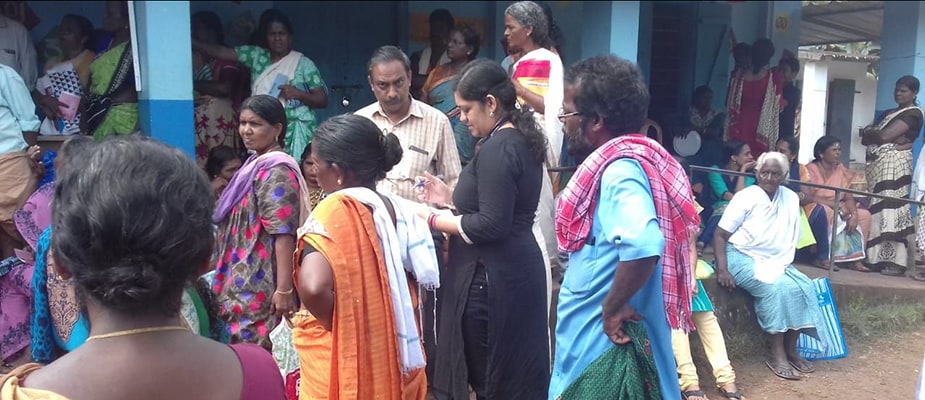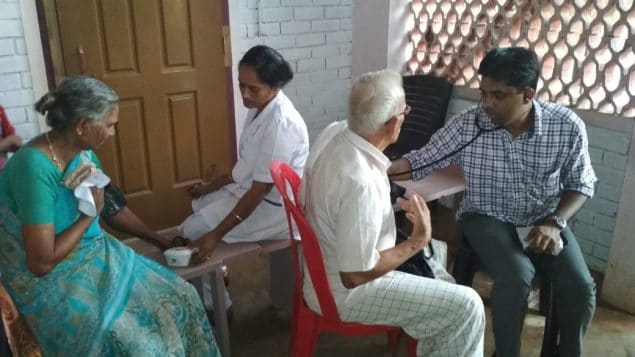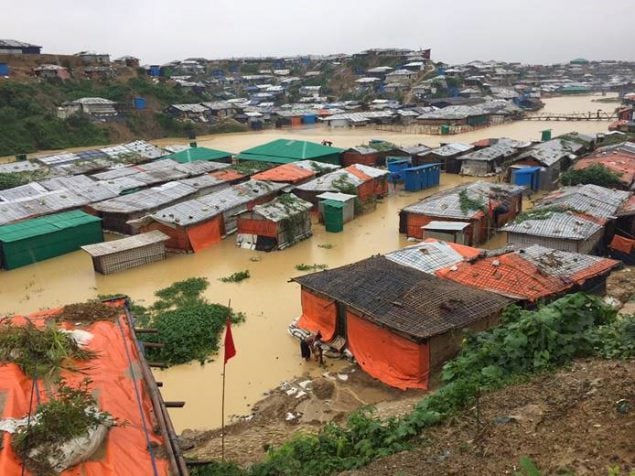Archive for the ‘Migration’ Category
In past four days alone, more than 150,000 Syrians flee villages as government forces close in on rebel-held Idlib.
Monday, February 17th, 2020Rohingya refugee boat sinks: Most of the victims were woman and children, fleeing the overcrowded refugee camps for Rohingya Muslims in Bangladesh.
Tuesday, February 11th, 2020Untreated chronic conditions can quickly become life-threatening in a refugee camp
Monday, December 16th, 2019CDC:
How Kerala Avoided a Chronic Disease Crisis

A field epidemiology resident connects with care providers and patients at a flood relief camp in Kumarakom, Kerala. Photo: Renjith Krishna
A river of mud and debris surged through the streets of Kerala in August 2018. The southwestern Indian state was hit with unusually high rainfall during monsoon season, overflowing dams and causing devastating floods and landslides that affected hundreds of villages and destroyed thousands of miles of roads and homes.
Over one million residents were evacuated and many moved to relief camps. For those with chronic conditions like hypertension (high blood pressure) and diabetes, life in a relief camp without access to medication or medical records can be dangerous.
“During an emergency we often consider potential complications from communicable diseases, but untreated chronic conditions can quickly become life-threatening,” explains Dr. Ganeshkumar, a medical scientist with the Indian Council of Medical Research-National Institute of Epidemiology (NIE).
Nearly 1 in 3 people impacted by the flood were estimated to have diagnosed hypertension, but due to emergency conditions, nearly 90% of these flood victims were living with uncontrolled blood pressure. Left untreated, high blood pressure could become a “silent killer” causing heart disease, stroke, or kidney failure with little warning.
Springing into Action
Within days of the floods, Kerala’s state health department teamed up with NIE to develop an action plan to address noncommunicable disease (NCD) risk factors like uncontrolled hypertension in the flood region.
NIE established a multi-step approach to respond to the burgeoning crisis. The team prepared guidelines for the treatment of high-risk NCD conditions based on the latest research and global best practices, increased local NCD medication supplies, and coordinated referral systems for people requiring emergency medical care. They then established reporting protocols throughout the state so they could actively monitor the crisis.
“Streamlining NCD service delivery by integrating into primary care is challenging during emergencies due to the competing priorities and the scattered displacement of patients,” explains Dr. Bipin Gopal, State NCD Nodal Officer in Kerala. “High-level planning is essential to ensure commitment and allotment of resources, but collaboration with stakeholders in the field is absolutely critical for interventions to be successful.”
Ready in an Emergency

Local physicians screen for hypertension at a primary health center in Vanimal village in northern Kerala. Photo: Abishek S.
To help coordinate on-the-ground efforts, NIE deployed field epidemiology residents to the hardest hit districts in Kerala. Field epidemiologists, commonly referred to as disease detectives, are part of the global health workforce trained to guide the response to urgent public health problems by tracking, containing, and eliminating health threats.
Within a week after flooding began, the field epidemiology residents were collaborating with district medical officers and administrators to familiarize physicians in the relief camps and at primary care centers with the emergency treatment and referral guidelines. They provided support to increase public awareness about the danger of untreated NCDs and they trained health centers on the NCD emergency response monitoring system.
Chronic but Urgent
Since the 1980s, CDC has collaborated with countries to train a global workforce of field epidemiologists through the Field Epidemiology Training Program (FETP). FETP residents and graduates have responded to some of the world’s most urgent health events, including the Ebola virus outbreak in West Africa.
In 2018, CDC—in coordination with ministries of health, the World Health Organization, Resolve to Save Lives, and other global partners—launched an effort to strengthen NCD epidemiology within the training program, with a focus on cardiovascular disease and hypertension. Through intensive on-the-job training and mentorship, FETP NCD residents develop skills to quickly identify health risks, monitor health interventions, and use data to inform programs and policies.
Two of the epidemiologists who led the on-the-ground coordination in Kerala are part of the first FETP NCD cohort in India.
A Step Ahead
While Kerala is still recovering from the floods, health professionals in the region have provided over 100,000 NCD consultations. The quick action of NIE and the local field epidemiologist residents likely prevented scores of complications and deaths.
With chronic conditions requiring long-term care and sustained involvement from the health system, advocates of strengthening NCD prevention and control efforts have long asserted that health systems capable of addressing NCDs are more robust and better prepared to respond to all types of health threats.
All residents in India’s first FETP NCD cohort are now focusing on continuing to strengthen local health systems by supporting other districts on integrating hypertension and cardiovascular disease management into primary care.
“Field epidemiology training strengthens the national workforce and health system so that both can be responsive when an emergency occurs,” states Dr. Ganeshkumar. “We’ve seen that in action in Kerala.”
CDC: Preventing waterborne outbreaks in refugee camps
Monday, December 16th, 2019Hundreds of thousands of ethnic Rohingyas crossed the border into Cox’s Bazar, Bangladesh to escape violence in Rakhine State in Myanmar. More than 900,000 forcibly displaced Myanmar nationals live in refugee camps in Bangladesh. Because conditions are crowded and the area is prone to flooding, the risk of Acute Watery Diarrhea (AWD) and other waterborne disease outbreaks had to be reduced during the 2018 monsoon season. Humanitarian partners distributed household water treatment products throughout the camps and combined this with messages to promote good hygiene. However, a recent water, sanitation and hygiene (WASH) survey estimated that only 13% of households treat household water. Of the 182 households that reported to treat water using chlorine tablets, only 53 (21%) had detectable chlorine in their stored water, an indicator of whether water was treated and was protected from recontamination during storage in households. Bucket chlorination, where an attendant sitting by the well directly chlorinates each bucket of water as it is collected was also implemented, but only at a small number of wells. Because of low levels of household water treatment in the camps, the water, sanitation, and hygiene (WASH) team recommended to scale-up bucket chlorination to ensure households were using chlorinated water during the monsoon season.

The WASH team within CDC’s Emergency Response and Recovery Branch (ERRB) worked with UNICEF and non-governmental partners to increase bucket chlorination from June to September 2018. In July, ERRB WASH specialists measured chlorine levels in one camp to provide a snapshot of current levels of chlorine in the water. After this, the WASH team started a program to monitor bucket chlorination, using mobile phone surveys to ensure chlorinators were present and that chlorine was in water in nearby households. In addition, they piloted guidelines to help identify which drinking water wells should receive bucket chlorination first. Finally, the WASH team provided guidance to implementing partners on how to scale-up and improve bucket chlorination based on assessment and monitoring results.
In addition, CDC supported the WASH Sector in Cox’s Bazar and UNICEF by training local staff on how to conduct water quality testing and drafting guidance on water quality monitoring, including a system to monitor E. coli levels in wells through the dry and monsoon seasons.
The Rohingya face extremely challenging circumstances as they seek refuge in makeshift camps. The 2019 UN World Water Day theme is “leaving no one behind” and CDC seeks to assist partners in providing safe, treated drinking water to the world’s most vulnerable communities.
Greek refugee camps: “There is a desperate lack of medical care and sanitation in the vastly overcrowded camps……”
Monday, November 4th, 2019Thousands of people from Vietnam are smuggled to Europe every year on a route filled with violence and hardship.
Saturday, November 2nd, 2019“Vietnamese smugglers call it the “CO2” route: a poorly ventilated, oxygen-deficient trip across the English Channel in shipping containers or trailers piled high with pallets of merchandise, the last leg of a perilous, 6,000-mile trek across Asia and into Western Europe.
Compared to the other path — the “V.I.P. route,” with its brief hotel stay and seat in a truck driver’s cab — the trip in a stuffy container can be brutal for what some Vietnamese refer to as “box people,” successors to the “boat people” who left after the Vietnam War ended in 1975…..”
Extreme weather events displaced a record 7,000,000 people from their homes during the first six months of this year
Saturday, September 14th, 2019“…..floods, landslides, cyclones and other extreme weather events temporarily displaced more people in the first half of this year than during the same period in any other year...….”
IDMC’s mid-year figures reveal the most significant new internal displacements associated with conflict, violence and disasters around the world between January and June 2019. The report serves as an important temperature gauge of global displacement halfway through the year, looking ahead to the trends and patterns expected in the months to come.
Myanmar and Bangladesh are to make a fresh attempt to begin repatriating the Rohingya Muslims
Saturday, August 17th, 2019‘…..A document prepared by UN agency UNHCR to be sent to the Rohingya community to inform them of the repatriation plan said: “The Government of Myanmar has confirmed that 3,450 Rohingya refugees are eligible to return. This is a welcome first step as it acknowledges that your right to return is recognized.”……’
1,300 or more children of European fighters and followers of the self-professed caliphate remain trapped in Syria and Iraq. What to do?
Thursday, August 15th, 2019“….The issue is politically charged across Europe. ISIS survivors, even children, are seen as a threat, no matter how reformed they appear……”


